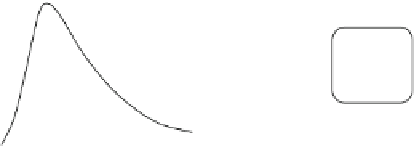Biomedical Engineering Reference
In-Depth Information
Fig. 1
A typical
pharmacokinetic curve for
C
(
t
)
AUC
C
C
max
V
d
Integrating it produces:
C
0
e
−
kt
C
(
t
)=
.
(2)
Thus for multiple simultaneous processes, a series of coupled differential equations
is obtained as stated above.
Nonlinear drug-organ interactions, however, cannot be described adequately
by classical compartment models. As observed in numerous sets of clinical data,
the concentration-time curve shows a non-exponential time-dependence, at least
asymptotically. Furthermore, observation of anomalous kinetics in the experimental
data also suggests that the kinetic reactions should occur on or within fractal media
with time-dependent kinetic rate coefficients [
1
,
33
].
Nonlinearity usually suggests that the underlying physical and chemical rela-
tionships are complicated. Among the various types of nonlinearities identified
in pharmacokinetic systems, a couple have been shown to follow a power law
relationship, signifying that scaling laws and universality may be present across a
wide range of patient characteristics as well as types and stage of disease. Clinically,
nonlinearity in the behavior of a drug can complicate the design of dosage regimes
as well as the prediction of the toxicity and effectiveness of the drug. The types
of nonlinearity that are discussed in the literature fall into two categories: dose-
dependence and time-dependence.
Dose-proportionality is a concept common in toxicity experiments or dose
escalation studies, which are primarily conducted early in the research of a
new drug. The response of patients to different doses of the drug is measured.
If the pharmacokinetic parameters are unchanged with changes in the dose, the
pharmacokinetics of the system are said to be dose-independent over the therapeutic
range studied. If a doubling of the dose of a drug produces a doubling in one or more
pharmacokinetic parameters, the system is considered to be dose-proportional and
linear. If the parameter values increase or decrease by a factor other than two, the
system is considered to be dose-dependent and nonlinear. Typically, the parameters
that are tested versus the dose are the area under the plasma-concentration curve
(
AUC
), which is often referred to as the systemic exposure, the maximum plasma
concentration (
C
max
), and the clearance (
CL
), which is a measure of the volume of
the blood that is cleared of drug per unit time (see Fig.
1
).































Search WWH ::

Custom Search